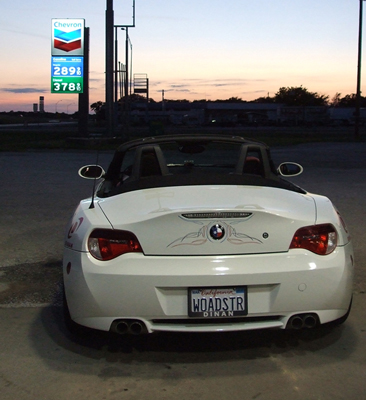Rob Siegel’s discussion of the electrical woes of his 5 Series this week struck a chord with me because it let me hark back to my own experiences with, um, unreliable electrics. Most of my own misadventures have not involved the alternator, but some of them have, so it’s you ‘n’ me, Brother Siegel.
The alternator is my primary suspect unless we’re talking about my Lotus days, in which the most likely source of any electrical gremlin was Joseph Lucas. (Yes, I still remember many Lucas jokes: What were Joseph Lucas’ last words? “Never drive at night!”) It is true that I carried two boxes of 30-amp fuses in the glove compartment of my Esprit just for the headlights, because the Esprit had new, improved headlights that rose from the hood through the power of electric motors, as opposed to the old, unimproved headlights of the Elite that were raised by spring pressure but lowered by a vacuum system, which leaked, of course (because Lotus), so while the car was parked, one headlight would slowly rise to the on position. The Lotus Elite—the ’70s-era car that looked like an elephant sat on a Gremlin, not the slippery little ’60s rocket—may be the only car that winked at you.
Anyway, the Esprit’s headlight motors drew a certain amount of current, and when that was added to the current draw of the headlights themselves, then often—but not always—the headlight fuse would blow. Fortunately, Lotus had thoughtfully installed a small fuse box right in the glove compartment dedicated to the headlight circuit, perhaps anticipating the validity of their reputation for reliability. Usually, replacing a blown fuse would bring the headlights back to life, but occasionally it would merely result in another blown fuse. Hence two boxes of spare 30-amp fuses.
But if we’re discussing other cars (and God knows we should be), then I’m with Siegel on alternators and batteries. (However, I am old enough to remember generators and their voltage-regulator conniptions. Anybody here remember the intricate ritual of polarizing the regulator?) It took me many years to discover that you really don’t have to live with the alternator that came with the car, especially if you have a smallish sports car with limited space under the hood; there are smaller alternators out there (perhaps for forklifts) that can be MacGyvered into position. I used Denso alternators the size of softballs in my Saab rally cars, because the original Bosch alternator managed to block access to the #1 spark plug on the V4 engine, and I think that removing the alternator in order to change a spark plug confirms bad design.
In addition, the OE Bosch unit employed a three-wire remote-mounted voltage regulator, the workings of which I have yet to understand; the Denso had one terminal to hook up to the electrical system, so even I could figure it out: Red Wire Goes Here. Voltage was controlled somewhere within the alternator, and I don’t need to know anything more than that. Sure, there may be a time when a skilled diagnostician might say, “No, it’s not the alternator, it’s the voltage regulator,” and apply a smug expertise to the disassembly, repair, and re-assembly of the entire unit, but life is short. If any of my dwarfish alternators had failed, I would have replaced it with a new one in about five minutes.

Build a box to hold the electrolyte, and presto! You have William Cruickshank’s trough battery.
When it comes to batteries, Siegel triggered old memories. Batteries themselves can present interesting challenges, like where to put them. In one of my cars, in order to provide maximum space in a square storage compartment, I installed two skinny Optima six-volt batteries at right angles to each other.

Put two of these end to end and you have one long skinny 12-volt battery.
Siegel mentions the fact that if the alternator goes kablooey, you can run quite a ways before the battery dies, as long as you’re in some ancient croaker without a lot of electrical crap, like, you know, engine management. I remember a time when three Alaska Rally Team cars were making it back from Fort Saint John to Anchorage when one of the cars—probably that stupid Karmann Ghia—suffered complete alternator failure. (Well, it didn’t explode, and it still served as a pulley for whatever belt ran it, but it just didn’t produce any volts for the battery.) So here we were in the Klondike wilderness, three cars, one dead battery, and nary a Pep Boys in sight. So we did as Rob suggests: We swapped a battery from one of the still-functioning cars to the one with the flat battery, and put the moribund unit into a car with a functioning alternator in the hope that the battery could be revived. We had to start the car by pushing it, of course, but that was barely a challenge. Then we would stop and swap batteries again when the replacement died, rotating all three batteries several times over the next thousand miles. Ah, the good old days.
As for modern cars, I can tell you that a modernish Ford Exploder will simply cease to run when the battery voltage gets too low (alternator problem again). In this case the solution was to buy a new battery or two and run them in parallel with the battery in the car, via a set of very long cables running from the passenger-side floorboard out the window and under the hood. Which meant the window had to be down at least a little in order for the jumper cables to pass through. At about twenty below. And when that battery eventually ran down, we replaced it with a new one at the next fuel stop. I don’t remember how many batteries I put on my credit card, but we made it from the Cassiar Highway to Oregon.
My more recent battery woes involved my Z4 M roadster. As I was getting it ready for the trip that took it to the BMW CCA Foundation’s Ultimate Driving Museum for display in their current Power of M exhibit, I found that the car would not start; it produced merely a sullen, clunky click at my turn of the key. “Well, rats!” I opined. “I guess I’m going to have to change the @#$! starting motor!” My reasoning was sound, because the battery could hardly be at fault, since I keep the car on a gen-you-wine BMW battery tender (read: Deltran). Besides, this battery couldn’t be the problem, because the car had battery issues when I bought it, and they replaced it for free with a new battery, and that was just a few months—
Oh, wait: It was 2008.
So I decided that I might as well go all out and splurge on a new battery as well as the starter, which I had ordered from Carl Nelson as soon as I watched enough YouTube videos to convince myself that I could change the damn thing. I did my diligent research, finding the cheapest—uh, the most cost-effective battery that would fit the Z4, bought it, and installed it in the fiendish battery location they chose for the Z4 M (kinda sorta, after I fashioned a wooden cleat to hold it in place; it fit within the allotted space, but with a few inches to spare). Reattaching the wires in the right places and getting the battery cover properly fit took about as long as you would expect it to take me, which is often considerably longer than I think it should take, but it all worked out.

Buried deep within that trunk is a battery cover, and beneath that cover is a battery: Abandon Hope All Ye Who Enter Here.
Then I decided, just for the hell of it, to turn the key.
Vroom! went the Z4 M roadster. “Where’s my phone?!” went the astonished owner. “Hello, Carl? Cancel that starter!” (If you want a heck of a deal on the starter for a 2006 BMW Z4 M roadster, you know where to call.)
This experience confirmed my choice of battery-maintenance thingies. In addition to at least three BMW/Deltran battery tenders, I also own two Optima units, mainly because they have more lights and displays on them. The Deltran has one LED which is red while the battery is charging and green when it’s allegedly full, while the Optima tells me the rate of charge, the voltage, how full the battery is now, and the phases of the moon, for all I know. I may not understand all the data, but I want all that it can give me.

I want all the information I can get.
Of course, when they asked if I wanted them to put the Z4 on a battery tender at the museum, I sent them the simple black box that had been allegedly maintaining it when the starter went click. So if they can’t get the car started when the exhibit is over, I think I’ll be able to guess the problem.—Satch Carlson





















